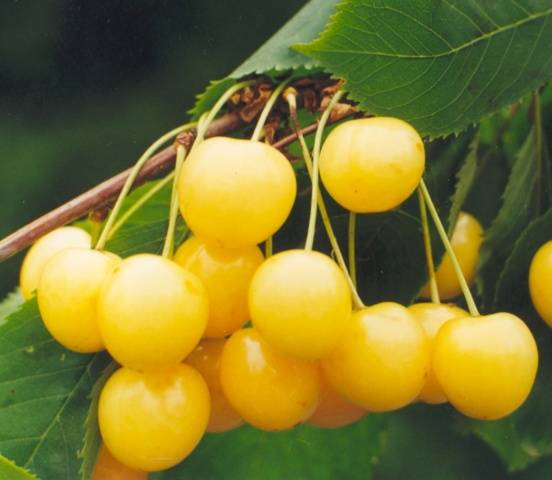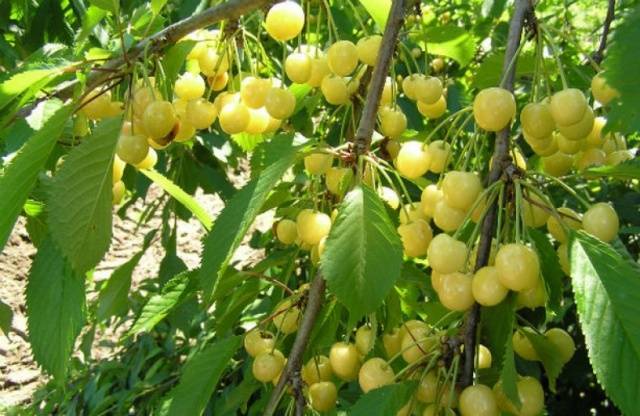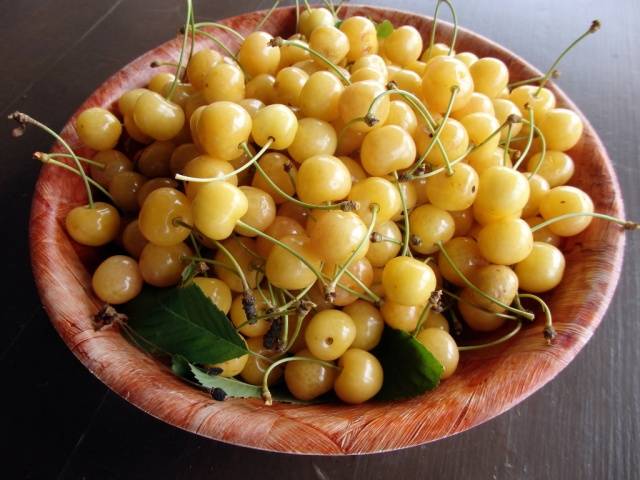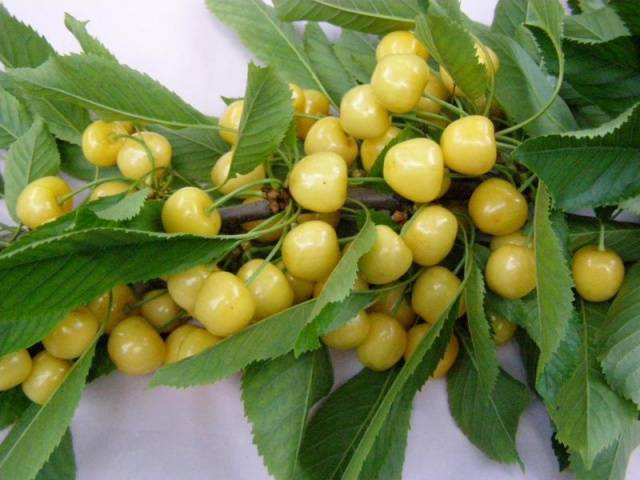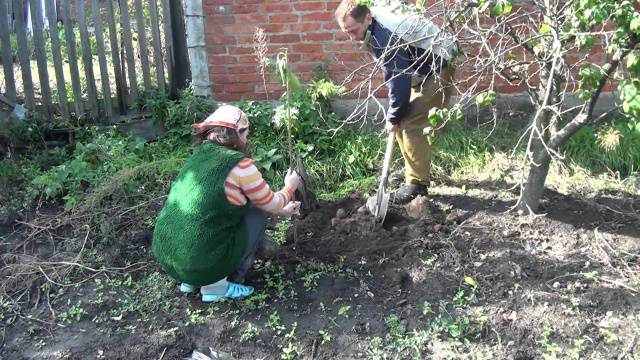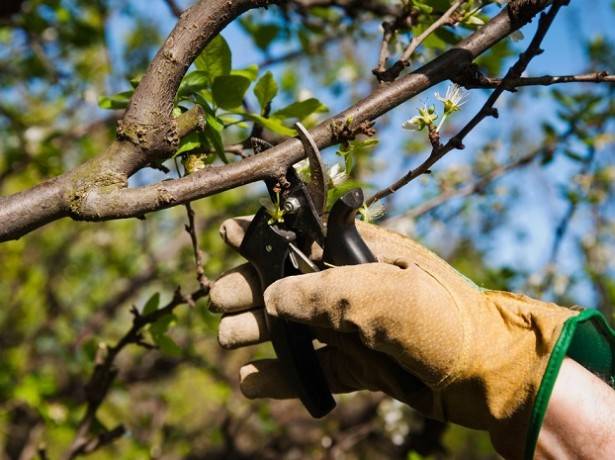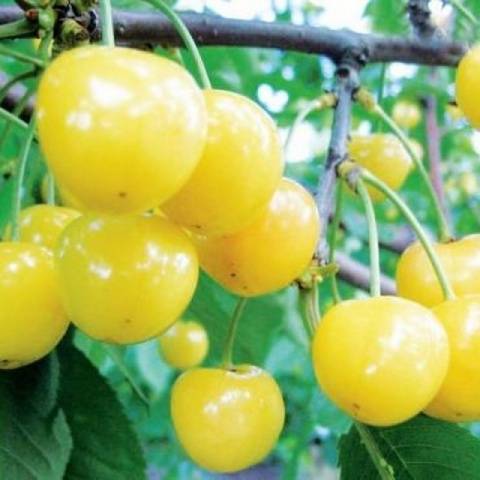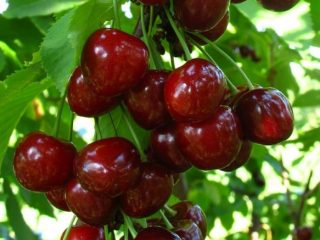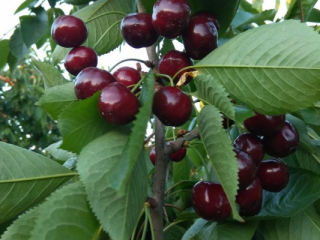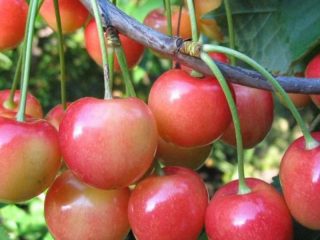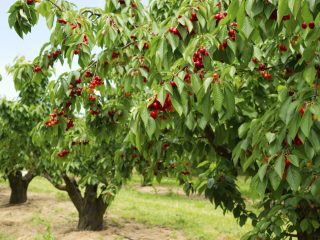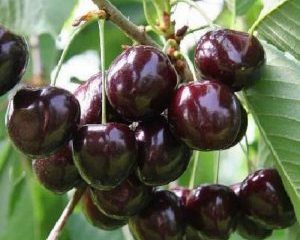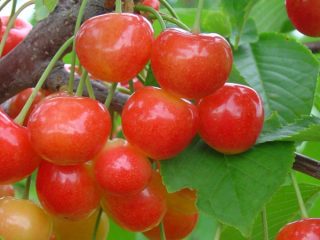Content
Sweet cherry Chermashnaya – early yellow variety cherries. Many people grow it on their plots precisely because of its early ripening.
History of selection
This type of cherry was artificially obtained from the seeds of Leningradskaya yellow cherry through free pollination at the All-Russian Institute for Growing New Plant Species. It has been included in the state register since 2004 for the Central region of Russia.
Description of culture
The tree has an average height of up to 5 meters and grows quickly. The crown is round and oval of medium density. The main branches form right and obtuse angles, which is often mentioned in the description of the Chermashnaya yellow cherry variety. The shoots are brownish-red. The leaves are medium in size, lance-oval in shape with small serrations and a pointed apex.
The berries of this cherry variety grow on branches in the form of bouquets and separately on some shoots.The fruits are yellow with a slight pink blush, round and medium large, weighing from 3.8 to 4.5 g. These are medium-sized berries, if you compare the Chermashnaya and Bull's Heart cherry varieties, the berries of which reach 10 g.
The pulp is the same color as the peel - yellow, juicy, delicate in taste, with virtually no sourness. The stone separates very well from the pulp and is smooth to the touch.
This variety is good for the Central and Southern regions of Russia. But it is worth considering that the soil for planting should not be heavy. Sandy and loamy areas are considered the best.
Characteristics
Characteristics of the Chermashnaya cherry variety is distinguished by its early harvest. It can withstand cold weather and is less vulnerable to diseases and parasites than others.
Drought resistance, winter hardiness
The winter resistance of the variety is average, just right for the Moscow region. When measuring the degree of freezing of the bark, the cherry received 1 and 2 points, which means the Chermashnaya cherry has good frost resistance. This species also tolerates drought well; in general, it is a heat-loving tree.
Pollination, flowering period and ripening time
The first berries appear already at the age of 3 years and by the end of June. Flowering begins before the tree is covered with leaves. The flowers are white and umbrella-shaped with round petals.
Pollination of the self-sterile Chermashnaya occurs through other trees. Varieties cope better with this task Raditsa, Shokoladnitsa, Crimean cherry and Fatezh.
Productivity, fruiting
Peak yield occurs in the 6th year after planting the seedling. From one cherry you can collect up to 30 kg of fruit. They do not ripen all at once, but one by one, but quickly, so the harvest should be harvested in several stages. From one hectare you can collect up to 86 quintals over the entire ripening period.
Area of application of berries
The most common is, of course, eating fresh berries of this variety. Early Chermashnaya cherries can be stored well for up to 4 days at an air temperature of +2 - +5 degrees and provided that a cutting is available. The berries can be kept in the freezer for no more than 4-5 months.
For transportation, cherries should also be picked with cuttings in dry weather. The berry is suitable for canning (jams, compotes).
Resistance to diseases and pests
This variety is quite resistant to diseases caused by fungi and leaf-eating pests. But if not properly cared for, the plant can get sick and even die.
Advantages and disadvantages
The advantages include, first of all, the excellent sweet taste of cherries, early ripening of fruits, stable high-level productivity and early fruiting, as well as sufficient resistance to frost and pests. Among the shortcomings, the main and important factor is self-sterility.
Landing Features
Before planting a young seedling, several important points should be completed: choose the ideal place, treat the area with fertilizers, etc.
Recommended timing
Planting young cherries is recommended by experts in early spring. This is worth remembering when growing Chermashnaya cherries, despite the high frost resistance of the variety.
Choosing a suitable location
An ideal site would be one with good air flow and normal access to sunlight, but not a low-lying one. The soil is recommended to be loose with good moisture permeability, no closer to groundwater than 1.7 m. Dense soils are strictly not suitable: peat, sand, clay.Soil acidity should not exceed pH 6.5.
What crops can and cannot be planted next to cherries?
Nearby you can plant varieties that are pollinators for Chermashnaya cherries, for example cherry, it will act as a pollinator, like other types of cherries. Stone fruit trees require separate planting from other fruit varieties. It is not recommended to plant it near bushes. Also, cherries can ruin an apple tree if they are in close proximity.
Selection and preparation of planting material
Some gardeners make cuts at the tips of thick roots just before planting in the ground.
It is best to buy seedlings in nurseries and specialized stores.
What you should first pay attention to when choosing planting material for the yellow cherry variety Chermashnaya:
- Roots. They should not be frozen or dry.
- The root length is at least 25 cm.
- The presence of a sufficient number of fibrous roots.
- White color of the root in section.
- Check to see if there are any growths or swellings on the roots.
- The trunk of a young plant should have a smooth, undamaged texture.
- The ideal age of a seedling is 2 years.
- Leaves. If they are present, the plant may be dehydrated.
- If the root is in the ground, you need to make sure that it is in order.
Landing algorithm
First of all, you need to prepare a place for planting. This should be a recess approximately 90x90x90 cm. A small mound should be left at the bottom, and a support should be hammered in at a short distance from the middle. Next, the seedling is covered with earth.
After filling it with soil, you need to lightly trample it with your foot and make a border in a circle at a distance of 25 cm from the seedling. At the end, be sure to water the young cherries with a sufficient amount of water (about 3 buckets). You can add compost, ash or peat to the mound.
Subsequent care of the crop
Just like planting and caring for Chermashnaya cherries should be proper. Before the tree enters the period of fruiting in the first years, 1/5 of all shoots should be cut off. You can fertilize cherries in the fall with superphosphates. Calculation: approximately 2-3 tablespoons per 1 square meter. m crown projection and water generously.
Diseases and pests, methods of control and prevention
| Disease | Fighting methods | Prevention |
| Moniliosis or gray mold | Cut off affected branches Treatment with Hom or copper oxychloride solution | Digging up a tree area in the fall Drying the soil Treatment of wood with urea 5% |
| Brown leaf spot | Treatment with copper sulfate, Bordeaux mixture 1% | Cleaning affected areas of wood and fallen leaves, treating with solutions |
| Clusterosporiasis | Treatment with Nitrafen and Bordeaux mixture | Cleaning up fallen leaves in autumn |
| Pest | Way to fight | Prevention |
| Cherry aphid | Wood treatment with Actellik and Fitaverm or Inta-vir | Removing fallen leaves and digging up the ground under the cherry tree |
| Cherry tube gun | Spraying with Chlorophos, Metaphos, Actellik and Corsair | Caring for the under-crown area |
| Slimy cherry sawfly | Treatment with solutions (Karbofos, Iskra DE and M, Decis) | Urea treatment 3% and soil care |
Conclusion
In conclusion, it is worth saying that the Chermashnaya cherry is an excellent variety of early ripening and early cherries. It is unpretentious and resistant to different weather conditions, and its fruits have excellent taste.
Reviews
Below are several reviews from summer residents about Chermashnaya cherries in the Moscow region.
